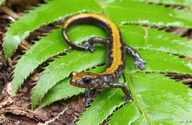|
Plethodon idahoensis Slater & Slipp, 1940
Coeur d'Alene Salamander Subgenus: Hightonia | family: Plethodontidae subfamily: Plethodontinae genus: Plethodon |
 © 2024 Jake Scott (1 of 5) |
|
|
Plethodon idahoensis Slater and Slipp, 1940 Kirk Lohman1 1. Historical versus Current Distribution. Coeur d'Alene salamanders (Plethodon idahoensis) are locally distributed in northern Idaho, northwestern Montana, and extreme southeastern British Columbia (Corkran and Thoms, 1996; Wilson and Ohanjanian, 2002). Knowledge of their range has been greatly extended from the original description of one location in northern Idaho (Slater and Slipp, 1940; for example see Dumas, 1957; Teberg, 1963, 1965; Nussbaum et al., 1983; Leonard et al., 1993; Wilson and Ohanjanian, 2002). Coeur d’Alene salamanders previously were considered a subspecies of Van Dyke's salamanders (P. vandykei), which occur in western Washington (Howard et al., 1993; Leonard et al., 1993). Their historical distribution is unknown. 2. Historical versus Current Abundance. Rare, but Coeur d’Alene salamanders may be abundant in small pockets (Wilson and Ohanjanian, 2002). Their historical abundance is unknown. 3. Life History Features. A. Breeding. Reproduction is terrestrial. i. Breeding migrations. Mating can occur from August–April, with peaks in the fall and early spring (Lynch, 1984). In areas with harsh springs, most animals breed in the fall, whereas breeding in the spring is more common in more temperate locales (Lynch, 1984). Migratory behavior is unknown. ii. Breeding habitat. Breeding apparently occurs just before and just after hibernation (Nussbaum et al., 1983; Lynch, 1984). Breeding and nest sites have been rarely observed. B. Eggs. i. Egg deposition sites. Have rarely been observed. ii. Clutch size. Females typically lay 1–13 eggs (Lynch, 1984). C. Direct Development. Hatching usually occurs in late summer and early fall (Nussbaum et al., 1983). D. Juvenile Habitat. Same as adult habitat. E. Adult Habitat. Most commonly found in semi-aquatic habitats: seepages, streamside talus, and splash zones (Nussbaum et al., 1983; Lynch, 1984); but may also occur in forest debris and damp talus (Slater and Slipp, 1940). F. Home Range Size. Wilson and Larsen (1988) reported the movement of adults 5–10 m away from splash zones during nocturnal activities, but little is known concerning home range size. G. Territories. Unknown. H. Aestivation/Avoiding Dessication. Nussbaum et al. (1983) reported that forest and talus-dwelling populations remain underground from June–September; populations along the Kootenai River, Montana, however, were inactive in mid summer only during periods of high daytime temperature and little rainfall (Wilson and Larsen, 1988). I. Seasonal Migrations. None reported. J. Torpor (Hibernation). Coeur d’Alene salamanders hibernate from late November to early March (Nussbaum et al., 1983). K. Interspecific Associations/Exclusions. Unknown. L. Age/Size at Reproductive Maturity. Age at first reproduction is 3.2–3.5 yr, with an SVL of 42–48 mm (Lynch, 1984). M. Longevity. At least 5 yr (Lynch, 1984). N. Feeding Behavior. Prey consists primarily of aquatic and semi-aquatic insects, including collembolans, dipterans, coleopterans, hemipterans, and acarinids, as well as homopterans and hymenopterans (Lindeman, 1993; Wilson and Larsen, 1988). O. Predators. Generally unknown, but predation by American robins (Turdus migratorius) has been documented (Wilson and Simon, 1985), and predation by shrews (Soricidae) or invertebrates (possibly carabid beetles [Scaphinotus sp.]) has been inferred (Staub, 1995). P. Anti-Predator Mechanisms. Nocturnal. Occasionally will coil as if to imitate a millipede; may rarely coil and uncoil to flip away if disturbed (Nussbaum et al., 1983). Q. Diseases. Unknown. R. Parasites. Unknown. 4. Conservation. The historical distribution and abundance of Coeur d'Alene salamanders is unknown. They can be abundant in small pockets (Wilson and Ohanjanian, 2002). Coeur d'Alene salamanders are considered a Species of Special Concern in both Idaho and Montana.1Kirk Lohman Literature references for Amphibian Declines: The Conservation Status of United States Species, edited by Michael Lannoo, are here. Feedback or comments about this page.
Citation: AmphibiaWeb. 2025. <https://amphibiaweb.org> University of California, Berkeley, CA, USA. Accessed 21 Jan 2025. AmphibiaWeb's policy on data use. |



 Raffaëlli Account
Raffaëlli Account Map of Life
Map of Life